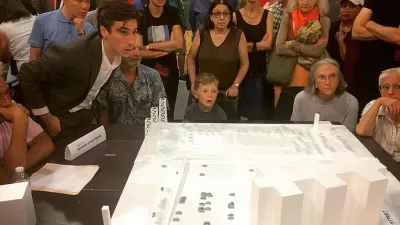Economic crises tend to manifest themselves in specific design trends, especially in the field of architecture. This latest recession has spurred the age of Do-It-Yourself architecture and urbanism.
In the first part of a four-part series for Places, Mimi Zeiger looks at how the trend of DIY urbanism is playing out.
"Our current recession is inspiring its own strategies and tactics: It's increasingly a catch-all for a host of urban interventions. This is a trend that I like to describe with a mouthful of a title: Provisional, Opportunistic, Ubiquitous, and Odd Tactics in Guerilla and DIY Practice and Urbanism. With this verbaciousness, I hope to capture the tactical multiplicity and inventive thinking that have cropped up in the vacuum of more conventional commissions. These days vacant lots offer sites for urban farming, mini-golf, and dumpster pools. Trash recycles into a speculative housing prototype (see the Tiny Pallet House). Whether it's The Living's Amphibious Architecture or Mark Shephard's Serendipitor, the built environment speaks through mobile devices. Retail spaces hit by the recession are fodder for reinvention, as the art organization No Longer Empty transforms unleased storefronts into temporary galleries. Even the street itself is reclaimed. REBAR's annual initiative, Park(ing) Day, urges global participants to use a pranksters wit to turn parking spaces into pocket parks, one quarter at a time."
FULL STORY: The Interventionist's Toolkit

Maui's Vacation Rental Debate Turns Ugly
Verbal attacks, misinformation campaigns and fistfights plague a high-stakes debate to convert thousands of vacation rentals into long-term housing.

Planetizen Federal Action Tracker
A weekly monitor of how Trump’s orders and actions are impacting planners and planning in America.

Chicago’s Ghost Rails
Just beneath the surface of the modern city lie the remnants of its expansive early 20th-century streetcar system.

Bend, Oregon Zoning Reforms Prioritize Small-Scale Housing
The city altered its zoning code to allow multi-family housing and eliminated parking mandates citywide.

Amtrak Cutting Jobs, Funding to High-Speed Rail
The agency plans to cut 10 percent of its workforce and has confirmed it will not fund new high-speed rail projects.

LA Denies Basic Services to Unhoused Residents
The city has repeatedly failed to respond to requests for trash pickup at encampment sites, and eliminated a program that provided mobile showers and toilets.
Urban Design for Planners 1: Software Tools
This six-course series explores essential urban design concepts using open source software and equips planners with the tools they need to participate fully in the urban design process.
Planning for Universal Design
Learn the tools for implementing Universal Design in planning regulations.
planning NEXT
Appalachian Highlands Housing Partners
Mpact (founded as Rail~Volution)
City of Camden Redevelopment Agency
City of Astoria
City of Portland
City of Laramie




























